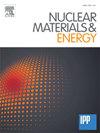Deuterium retention behaviors of boronization films at DIII-D divertor surface
IF 2.3
2区 物理与天体物理
Q1 NUCLEAR SCIENCE & TECHNOLOGY
引用次数: 0
Abstract
Boron coating of plasma-facing components (PFCs) is widely used in fusion devices to form surface coatings and chemical compounds on the PFCs, thus suppressing plasma contamination by impurities such as oxygen, carbon, and tungsten. Understanding the processes of hydrogenic species retention is crucial to assessing the viability of boron coating techniques in ITER and beyond. In this work, we deposited boronization films on silicon crystal and ITER-grade tungsten samples using a glow discharge boronization plasma of helium (He, 85 %) and diborane (B2D6, 15 %) in the DIII-D tokamak at the heated vessel temperature of 600 K. We performed post-mortem analysis of DIII-D boronization films for thickness utilizing a focused ion beam, deuterium retention utilizing thermal desorption spectroscopy (TDS), and chemical characterization utilizing X-ray photoelectron spectroscopy and Raman spectroscopy. The DIII-D boronization films were exposed to DIII-D tokamak L-, H-mode, and/or PISCES-E linear device D plasmas. We observed a D uptake for B:D = 5:2 in the DIII-D boronization film before D plasma exposures. The observed D retention was mainly in the B![]() C
C![]() D bond with a desorption peak of 1000 K. No B-D bond with a desorption peak around 700 K was found in the TDS spectrum as the DIII-D vessel was heated to 600 K. Exposures to both DIII-D L- and H-mode D plasma, which includes 1–3 % of C ion contamination, on the DIII-D boronization film at ∼400 K gave a D uptake increase of ∼20 %. Contrarily, D removal by ∼30 % was observed after exposing the DIII-D boronization film to a carbon-free PISCES-E D plasma. This implies that future fusion devices should be careful to minimize C impurity contamination to reduce D retention.
D bond with a desorption peak of 1000 K. No B-D bond with a desorption peak around 700 K was found in the TDS spectrum as the DIII-D vessel was heated to 600 K. Exposures to both DIII-D L- and H-mode D plasma, which includes 1–3 % of C ion contamination, on the DIII-D boronization film at ∼400 K gave a D uptake increase of ∼20 %. Contrarily, D removal by ∼30 % was observed after exposing the DIII-D boronization film to a carbon-free PISCES-E D plasma. This implies that future fusion devices should be careful to minimize C impurity contamination to reduce D retention.
硼化膜在DIII-D分流器表面的氘保留行为
等离子体表面组件(pfc)的硼涂层广泛用于聚变装置,在pfc上形成表面涂层和化合物,从而抑制氧、碳和钨等杂质对等离子体的污染。了解含氢物质的保留过程对于评估ITER及以后硼包覆技术的可行性至关重要。在DIII-D托卡马克中,在600 K的加热容器温度下,利用氦(He, 85%)和二硼烷(B2D6, 15%)的辉光放电硼化等离子体在硅晶体和er级钨样品上沉积了硼化膜。我们利用聚焦离子束对DIII-D硼化膜的厚度进行了事后分析,利用热解吸光谱(TDS)对氘保留进行了分析,并利用x射线光电子能谱和拉曼能谱对其进行了化学表征。将DIII-D硼化膜暴露于DIII-D托卡马克L-、h -模式和/或PISCES-E线性器件D等离子体中。在D等离子体暴露前,我们观察到DIII-D硼化膜中B:D = 5:2的D摄取。所观察到的D保留主要在BCD键中,其解吸峰为1000 K。当DIII-D容器加热到600 K时,在TDS谱中没有发现在700 K附近有解吸峰的B-D键。暴露于DIII-D L型和h型等离子体,其中包括1 - 3%的C离子污染,在~ 400 K的DIII-D硼化膜上,D摄取增加了~ 20%。相反,在将DIII-D硼化膜暴露于无碳PISCES-E -D等离子体后,观察到D去除率为~ 30%。这意味着未来的聚变装置应该小心地减少C杂质污染,以减少D潴留。
本文章由计算机程序翻译,如有差异,请以英文原文为准。
求助全文
约1分钟内获得全文
求助全文
来源期刊

Nuclear Materials and Energy
Materials Science-Materials Science (miscellaneous)
CiteScore
3.70
自引率
15.40%
发文量
175
审稿时长
20 weeks
期刊介绍:
The open-access journal Nuclear Materials and Energy is devoted to the growing field of research for material application in the production of nuclear energy. Nuclear Materials and Energy publishes original research articles of up to 6 pages in length.
 求助内容:
求助内容: 应助结果提醒方式:
应助结果提醒方式:


